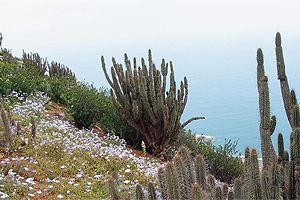As we know, vegetation is determined by the atmospheric element (for example, the amount of precipitations) and this, besides) conditions the animal life.
In general terms, in the Region of Antofagasta prevails the climates of desert type, which characteristic vegetation is the xeromorfic one, in other words, the one that has adapted to extreme arid conditions? The representative species are herbs, cactuses, tamarugo, chañar, etc.
However, it can noticed in this region three fitogeographic units well differentiated: the coastal desert, the absolute desert and the Andean desert.
We shall chiefly describe them including, and besides, the most important aspects of its fauna, as it follows bellow:
– Coastal desert: this zone is characterized for containing numerous vegetable species, most of which are endemic. We must distinguish that the coastal desert, north of Antofagasta is known as Tocopilla coastal desert and southwards such city is Taltal coastal desert.
The Tocopilla coastal desert is more arid and only with a vegetation development in some places such as the Mejillones peninsula and in the Chimba creek. Among the most representative species, there are: the salitre (Frankenia chilensis), the Chañarcillo (Lycium chanar), the Piojillo (Malesherbia humilis), the Tupac llano (Sicyos bryonaefolius), the Alcaparra (Cassia brogniartii) and the Suspiro (Nolana sedifolia).
– The Taltal coastal desert is less arid than the Tocopilla one, since there is more low fog and, thus, more sapecies proliferate, such as the Cacho de Cabra (Skytanthus acutus), the Hierba de yesca (Chuquiraga ulicina), the Chamiza (Bahia ambrosioodes), the Salitre ( Frankenia chilensis), the Uvillo (Monttea chilensis), the Pacul (Krameria cistoidea), the Tigridia (Tigridia philippiana), the Suspiros (Nolana sedifolia, N. divaricata y N. sleptophylla), the Rabo de Zorro (Ophryosporus gracilis), the Aji (Hoffmanseggia gracilis) and the Te de Burro (Dinemandra ericoides).
Also, stands out the cactus plants of the genus Copiapoa, Eriosyce, Neoporteria, Eulyc hnia and Echinopsis. This abundance of vegetable species influences also the existence of great quantities of birds, among which, Yales (Phygilus fruticeli) and Jilgueros (Carduelis barbatus).
– Absolute desert: this is one of the most arid zones of the world, with an absolute lack of vegetation, except, in places with special conditions such as water places. In these, there can be very resistant species, such as the Cachiyuyo (Atriplex desrticola), the Calpiche (Lyc ium minutifolium), the Cadillo (Acaena canescens) and the Grama salada (Distichlis canescens). The absence of vegetation determines the almost non existence of fauna, except for some species of reptiles and insects.
– The Andean Desert: in this area, in general, there id more vegetation than in the latter ones due to the influence of the high plateau winter.
In this zone are given some differentiated situations regarding climate and, thus, to vegetation and fauna.
First of all, is the superior basin of the Loa river, that has species Duch as the Rica-rica (Acantholippia punensis), the Cauchal (Coldenia atacamensis), the Allaval (Adesmia atacamensis), the Ojalar (Atriplex imbricada), the Oreganillo (Acantholippia trifida). This scarce vegetational development shelters some rodents such as the Vizcacha (Lagidium viscacia), some lizards of the genus Liolaemus and birds such as the Suri (Petrocnemia pennata). The other area is the basin of the Atacana salpan carachterized for having more humidity and for presenting some stepper species and trees. Among the first outstands the Brea (Tessaria absinthioides), the Suncho(Baccharis juncea), the Grama salada (Disatichlis spicata), the Oreganillo (Acantholippia trifida) and among the trees, there is, the Algarrobo (Prosopis chilensis) and the Chañar (Geoffroea decorticans). In the saltpan lagoons we can find numerous birds, among which, there are the three species of flamingos existing in Chile.
(Phoenicopterus chilensis), (Phoenicoparrus andinus) and (Phoenicoparrus jamesi) and the Pollito de Mar (also, Phalaropus tricolour); it cabn be seen the Zorro Culpeo (Pseudalopex culpaeus) or the Puma (Puma concolor).
– In the high plateau and following the Andean desert, there are given two ecological situations. One of them is the mountain sickness, which ambience is drier and determines poorer vegetation. Among its most common are the Pata de Pazaca (Fabiana bryoides), the Coiron Amargo (Stipa chrysophylla), the Susurco (Mulinium crassifolium), the Paja Amarrilla (Stipa frigida) and the Copa (Artemisa copa). The second situation is the one that develops around the saltpans, where is given a vegetation population similar to the Arica and Parinacota wetlands, but less richer and called Jarillar, which contains species such as: the Jarilla (Adesmia sentis), the Pingopingo (Ephedra breana), the Junquillo (Juncus balticus), the Garbanzo Silvestre (Stragalus bustillosii), the Cachiyuyo (Atriplex deserticola), the Pichi romero (Fabiana imbricate), the Chapin (Opuntia ovata), and the Ratonera (Hordeum comosum). Around the water there are some species of reptiles, amphibians, insects and birds. Of this latter group stands out the Cauquen guallata (Cloephaga maelanoptera), the Pato puna (Anas puna) and the Gaviota andina (Larus serranus).








 Muere Evita
Muere Evita